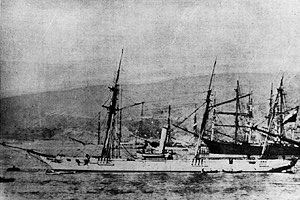Schooner Virjen de Covadonga
| This article does not cite any references or sources. Please help improve this article by adding citations to reliable sources. Unsourced material may be challenged and removed. (September 2008) |
 Covadonga at berth in Valparaiso, Chile | |
| Career (Spain) | |
|---|---|
| Name: | Virjen de Covadonga |
| Ordered: | June 10, 1857 |
| Builder: | Arsenal de la Carrara shipyard (Cádiz, Spain) |
| Cost: | 5.000.000 Reales de Vellón |
| Laid down: | February 13, 1858 |
| Launched: | November 28, 1859 |
| Commissioned: | October 8, 1859 |
| Captured: | Battle of Papudo, November 26, 1865 |
| Fate: | Captured by Chilean Navy during theChincha Islands War |
| Career (Chile) | |
| Name: | Covadonga |
| Commissioned: | December 4, 1865 |
| Fate: | Sunk by a mine in Chancay, Peruduring the War of the Pacific, September 13, 1880 |
| General characteristics | |
| Class and type: | screw-propelled schooner |
| Tons burthen: | 630 tons |
| Length: | 107 ft (33 m) |
| Propulsion: | 160 CV (120 kW) steam engine made in the Factory Nº 4, El Ferrol 1-shaft |
| Sail plan: | Brigantine sail rigging |
| Speed: | 7 kn (13 km/h) on steam |
| Complement: | 110 crewman |
| Armament: | 2 70-pounder (200 mm) revolving guns |
| Notes: | (*) Installed after May 21, 1879 |
The schooner Virjen de Covadonga (1859) was a ship that participated in the Chincha Islands War and the War of the Pacific, under Spanish and Chilean flags. She was launched in 1859 and a mine sank her in 1880.
Contents[hide] |
[edit]Construction
A Royal Order of June 10, 1857 led toCovadonga's keel being laid at the Arsenal de la Carrara in Cádiz, Spain, on February 13, 1858. She was a wooden schooner that was also fitted with steam propulsion. She was launched on November 28, 1859 and her construction had cost a total 5 million Reales de Vellón. She was named for the Battle of Covadonga - a highly symbolic event in Spanish history, being considered the beginning of the Reconquista.
She was commissioned by Royal Command on October 8, 1858 Her first commander was Lieutenant Evaristo Casariego y García. She was originally intended as a mail boat between Manila and Hong Kong, with her berth at the Naval Base of Manila, in the Philippine Islands.
[edit]Chincha Islands War service
During the Chincha Islands War, theCovadonga served as an auxiliary ship to the Spanish fleet. The Chilean corvetteEsmeralda, under the command of captainJuan Williams Rebolledo, capturedCovadonga during the Naval Battle of Papudo, on November 26, 1865. Her capture led to Spanish Admiral Juan Manuel Parejacommitting suicide.
Covadonga was commissioned into the Chilean navy on December 4, 1865, under her original name. During this war, she also participated at the Naval Battle of Abtao.
[edit]War of the Pacific service
During the War of the Pacific, the Covadonga together with the Esmeralda, as the oldest and slowest ships of the Chilean navy, were left behind to blockade the port of Iquique. There they participated in one of the most important naval battles of the war.
The Esmeralda faced the Huascar at the Naval Battle of Iquique, and the Covadonga manage to escape from the attacks of the Peruvian ironclad Independencia when the latter collided with a submerged rock and sank, after trying to ram the schooner; in the so called Naval Battle of Punta Gruesa, both on May 21, 1879.
[edit]Fate
On September 13, 1880, while enforcing a blockade in the port of Chancay, Peru, the sailors of theCovadonga saw an unmanned boat loaded with fresh fruits and produce being carried by the currents. When they tried to lift the boat it exploded as the Peruvians had rigged it as a floating mine.Covadonga sank in less than 10 minutes.
In the disaster, out of the 109 men of the crew, the commander Captain Pablo Ferrari and 32 sailors died, the gun-boat Pilcomayo rescued 29, and the Peruvians captured 48. Among the dead was petty officer Constantino Micalvi, a survivor of the Naval Battle of Iquique.
No hay comentarios :
Publicar un comentario